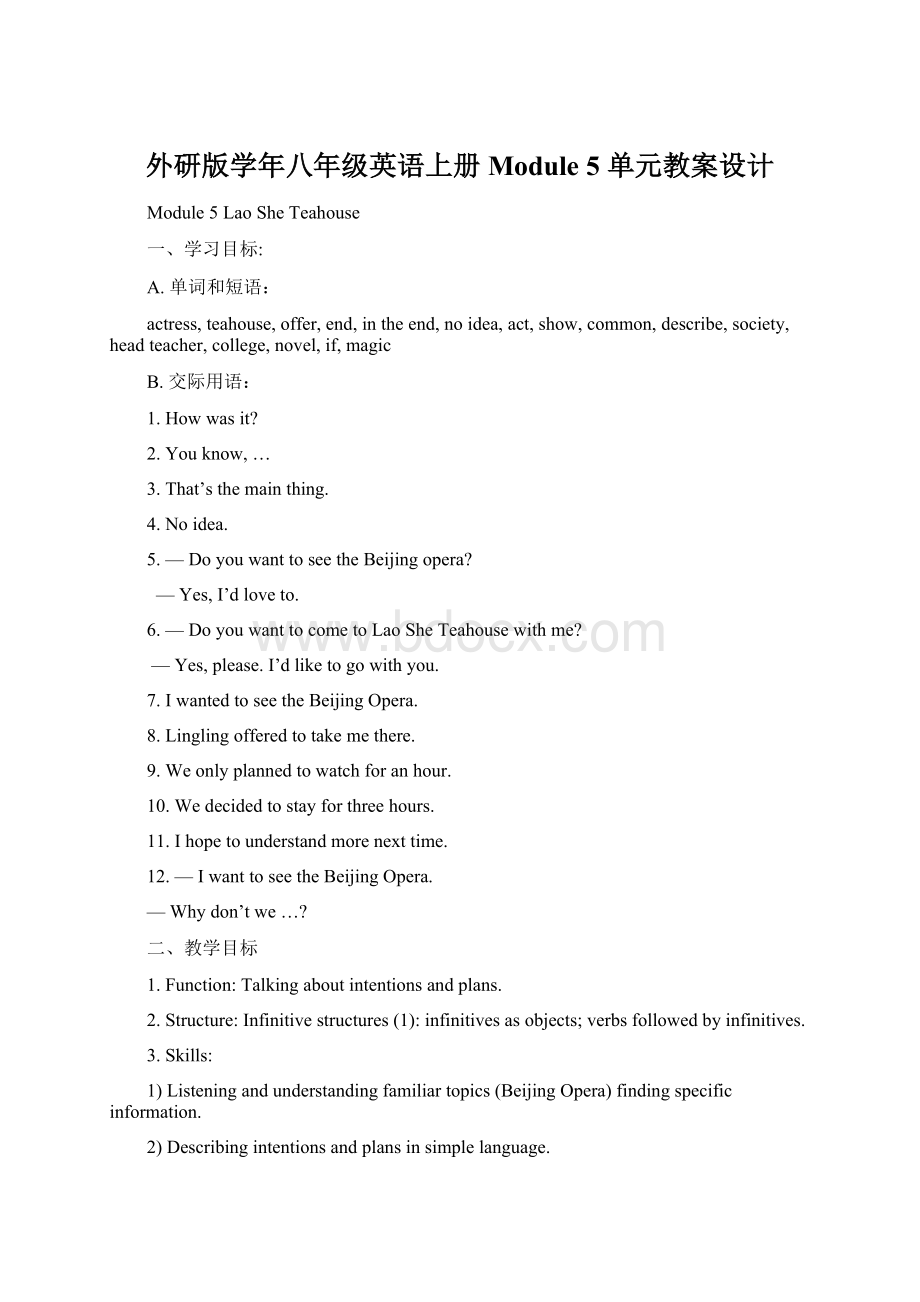外研版学年八年级英语上册Module 5 单元教案设计.docx
《外研版学年八年级英语上册Module 5 单元教案设计.docx》由会员分享,可在线阅读,更多相关《外研版学年八年级英语上册Module 5 单元教案设计.docx(19页珍藏版)》请在冰豆网上搜索。

外研版学年八年级英语上册Module5单元教案设计
Module5LaoSheTeahouse
一、学习目标:
A.单词和短语:
actress,teahouse,offer,end,intheend,noidea,act,show,common,describe,society,headteacher,college,novel,if,magic
B.交际用语:
1.Howwasit?
2.Youknow,…
3.That’sthemainthing.
4.Noidea.
5.—DoyouwanttoseetheBeijingopera?
—Yes,I’dloveto.
6.—DoyouwanttocometoLaoSheTeahousewithme?
—Yes,please.I’dliketogowithyou.
7.IwantedtoseetheBeijingOpera.
8.Linglingofferedtotakemethere.
9.Weonlyplannedtowatchforanhour.
10.Wedecidedtostayforthreehours.
11.Ihopetounderstandmorenexttime.
12.—IwanttoseetheBeijingOpera.
—Whydon’twe…?
二、教学目标
1.Function:
Talkingaboutintentionsandplans.
2.Structure:
Infinitivestructures
(1):
infinitivesasobjects;verbsfollowedbyinfinitives.
3.Skills:
1)Listeningandunderstandingfamiliartopics(BeijingOpera)findingspecificinformation.
2)Describingintentionsandplansinsimplelanguage.
3)Readingandunderstandingthesequenceofevents.
4)Writingashortpassageaboutfavouriteplayorfilm.
4.Aroundtheworld:
Theatres
5.Task:
Actingoutascenefromaplay.
三、重点及难点:
Infinitivestructures
(1):
infinitivesasobjects;verbsfollowedbyinfinitives.
四、教学设计:
Unit1IwantedtoseetheBeijingOpera.
ⅠTeachingmodel
Listeningandspeaking
ⅡTeachingmethod
PWPapproach
ⅢTeachingaims
1.Keyvocabulary:
actress,teahouse,offer,end,intheend,noidea
2.Keystructures:
Infinitivestructures
(1):
infinitivesasobjects;verbsfollowedbyinfinitives.
3.Keysentences:
1)Howwasit?
2)Youknow,…
3)That’sthemainthing.
4)Noidea.
5)—DoyouwanttoseetheBeijingopera?
—Yes,I’dloveto.
6)—DoyouwanttocometoLaoSheTeahousewithme?
—Yes,please.I’dliketogowithyou.
7)IwantedtoseetheBeijingOpera.
8)Linglingofferedtotakemethere.
ⅣTeachingaids
Taperecorder,OHP,video
ⅤTeachingSteps
Step1Warming-up
1.Enjoyaplay:
LaoSheTeahouse
2.Showsomepictures.
3.Lookatthepictures,andtalksomethingaboutthepictures.
4.Introducethenewwords.
5.Learnthenewwords.
6.Readthenewwords.
Step2Workinpairs.
1.AskthestudentstoreadthewordsintheboxinActivity1.
actressdancemusicplaysingteahousetheatretraditional
2.LookatthepicturesinActivity1,andtalkaboutthem.
3.Workinpairs.Usethewordsfromtheboxtohelpyou.
Step3Listeningpractice.
1.AskthestudentstoreadthroughthesentencesinActivity2.
1)Bettyoftensees/wantstoseesometraditionalBeijingopera.
2)Bettyknows/doesn’tknowLaoSheTeahouse.
3)Linglingsaysthattheoperaiseasy/difficulttounderstand.
2.Playtherecordingoncewithoutstopping.
3.Listenandunderlinethecorrectwords.
4.Playtherecordingagainandaskthewholeclasstocheckwithapartner.
5.Checktheanswers:
Keys:
1.wants2.doesn’tknow3.difficult
Step4Listenandread.
1.Showsomepictures,andaskthestudentstotalkaboutthem.
2.Askthestudentstoreadtheconversationsilently.
3.Playtherecordingandaskthestudentstolistenandreadtheconversation.
4.Readtheconversation.
5.Actitout.
6.Learn“EverydayEnglish”
1)Howwasit?
2)Youknow,…
3)That’sthemainthing.
4)Noidea.
Step5Checkthetruesentences.
1.Askthestudentstoreadtheconversationagain.
2.Nowcheckthetruesentences.
1)TonywenttoLaoSheTeahousewithBettyandLingling.
2)Bettyunderstoodtheopera.
3)LinglingandBettystayedlongerthantheyplanned.
4)Bettyenjoyedtheopera.
5)Bettywouldliketogototheoperaagain.
6)BettyknewaboutLaoShebeforeshewenttotheteahouse.
3.Askthestudentstocheckwithapartner.
4.Checktheanswers:
Keys:
1.×2.×3.√4.√5.√6.×
Step6Completethepassage.
1.AskthestudentstoreadthewordsintheboxinActivity4.
actressdifficultendmainoffer
2.Readthroughthepassage.
BettywantedtoseetheBeijingopera,soLingling
(1)________totakeBettytoLaoSheTeahouse.Thewordsoftheoperawere
(2)________tounderstand,buttheactorsand(3)__________wereexcellent.Theyonlyplannedtowatchforanhour,butinthe(4)________,theystayedforthreehours.Bettythoughtitwasinteresting—thatwasthe(5)________thing!
3.Completethepassagewiththecorrectformofthewordsfromthebox.
4.Askthestudentstocheckwithapartner.
5.Checktheanswers:
Keys:
1.offered2.difficult3.actresses4.end5.main
Step7Listenandrepeat.
1.Playtherecordingoncewithoutstopping.
2.Playtherecordingagainandaskthewholeclasstorepeat.
1)—DoyouwanttoseetheBeijingopera?
—Yes,I’dloveto.
2)—DoyouwanttocometoLaoSheTeahousewithme?
—Yes,please.I’dliketogowithyou.
3.Askthestudentstolistenandmarktheintonation.
4.Nowlistenagainandrepeat.
Step8Workinpairs.
1.AskthestudentstoreadtheconversationsinActivity5aloud.
2.Maketruesentences.
1)Iwantto___________nextweek.
2)Theyofferedto___________.
3)Ihopeto___________oneday.
4)Myparentsagreeto____________onSaturday.
3.Talkaboutsomethingyou’dliketodoorsee.
—IwanttogotoXinjiangandridehorses.
—…
Step9Importantanddifficultpoints
1.—WhoisLaoShe?
老舍是谁?
—Noidea.不知道。
这里的Noidea相当于Idon’tknow。
例如:
Shehasnoideawheretogo.
她不知道要去哪里。
—Doyouknowhowoldourteacheris?
—Ihavenoidea.Shelooksprettyyoung.
2.Weonlyplannedtowatchforanhour,butintheend,westayedforthreehours.
我们计划仅呆一个小时,但是最后,我们呆了三个小时。
in the end / at last / finally的区别:
这是一组同义词,都有“最后”的意思,但用法有所不同。
finally 一般指一系列事物或论点的顺序,没有感情色彩。
例如:
At last the work was done and he could rest.最后,工作完成了,他可以休息了。
She has come at last!
她总算来了!
in the end 表示经过许多变化、困难和捉摸不定的情况后某事才发生。
例如:
They won in the end.最后他们赢了。
Hetriedmanytimestopasstheexamination,andintheendhesucceeded.
他多次努力想通过考试,最后成功了。
in the end可与finally和at last通用,但注意:
in the end和finally不能用作感叹语。
Step10Doexercises:
A.单词拼写
1.They_________(提供)himaverygoodjob.
2.The__________(结局)isverysad.
3.Theactorsandactresses__________(女演员)wereexcellent.
4.Youshouldtrytogetthe_________(主要的)ideawhenyouarereading.
Keys:
1.offered2.end3.actresses4.main
B.完成句子:
1.他们提议建一所希望学校来帮助那些贫穷的孩子。
They___________________aHopeSchooltohelpthosepoorchildren.
2.你想要我带你去迪斯尼乐园吗?
Wouldyou__________________youtoDisneyland?
3.最后,我姐同意帮助我的英语。
______________,mysister______________helpwithmyEnglish.
4.他的梦想是长大当飞行员。
Hisdreamis___________________whenhegrowsup.
Keys:
1.offeredtobuild2.likemetotake3.intheend,agreedto4.tobe
C.中考链接
()1.A/An_________canusehisdrawingstotellaboutbeautifulmountains,theblueseaandmanyotherthings.(2013德州)
A.actorB.scientistC.artistD.doctor
()2.Thelittleboy________hisseattoanoldladyonthecrowdedbus.(2013莱芜)A.lentB.offeredC.tookD.brought
()3.Ourteacheroftenasksus____________questionsingroups.(2013北京)
A.discussB.todiscussC.discussingD.discussed
()4.—Wouldyoulikecampingwithme?
—I’dliketo.ButI’mbusymyhomework.(2013滨州)
A.togo;todoB.togo;doingC.going;todoD.going;doing
()5.—Canyoufinishthesebooksbefore10o'clock?
—Yes,Ican.(2013四川雅安)
A.toreadB.readC.readsD.reading
()6.Mr.Wangoftenencouragesus_______closetonatureandenjoyitsbeauties.(2013漳州)
A.getB.gettingC.toget
()7.—Wouldyoumind________inthedininghall?
—Ofcoursenot.(2013宜宾)
A.nottosmokeB.notsmokingC.smokeD.notsmoke
()8.Helosthiskey.Itmadehim________inthecoldtowaitforhiswife’sreturn.(2013重庆)
A.tostayB.stayedC.staysD.stay
Keys:
1.C2.B3.B4.B5.D6.C7.B8.D
Step11Homework
RememberthewordsofUnit1andpreparethetextofUnit2.
Unit2ItdescribesthechangesinChinesesociety.
ⅠTeachingmodel
Readingandwriting.
ⅡTeachingmethod
Top-downapproach
ⅢTeachingaims
1.Listeningandunderstandingfamiliartopics(BeijingOpera)findingspecificinformation.
2.Describingintentionsandplansinsimplelanguage.
3.Readingandunderstandingthesequenceofevents.
4.Writingashortpassageaboutfavouriteplayorfilm.
ⅣTeachingObjectives
1.Keyvocabulary:
act,show,common,describe,society,beginning,headteacher,college,novel,if,magic
2.Keysstructure:
Infinitivestructures
(1):
infinitivesasobjects;verbsfollowedbyinfinitives.
ⅤTeachingaids
Recorder,OHP,video
ⅥTeachingSteps
Step1Warming-up
1.Enjoyaplay:
LaoSheTeahouse
2.ReviewthetextofUnit1.
3.Showsomepictures.
4.Lookatthepictures,andtalksomethingaboutthepictures.
5.Introducethenewwords.
6.Learnthenewwords.
7.Readthenewwords.
Step2Workinpairs.
1.AskandanswerquestionsaboutLaoShe.
1)WhatdoyouknowaboutLaoShe?
2)Whatarehismostfamousbooksandplays?
3)What’sthespecialaboutLaoSheTeahouse?
2.TellthestudentsaboutLaoShe.
LaoShe(1899-1966)wasoneofthemostrenownedcontemporaryChinesewriters,famousforhisnovelsandplays.Hisworkshavebeentranslatedintoover20foreignlanguages.
Step3Reading
1.Playtherecordingandlistentothetapecarefully.
2.Askthestudentstoreadthroughthepassage.
3.Readthepassagebythemselves.
4.Readthetexttogether.
5.ReadthepassageandmatchtheheadingswiththeparagraphsinActivity2.
6.Checkwithapartner.
7.Callbacktheanswersfromthewholeclass.
Keys:
1b2c3a
Step4Completethetimeline.
1.Readthepassageagain.
2.Completethetimelinewithin